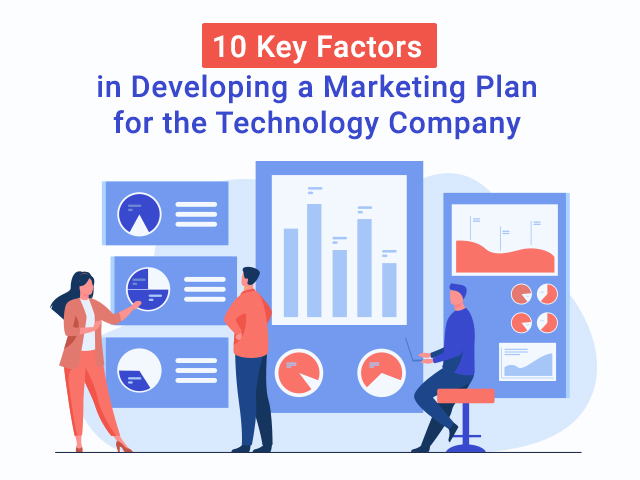
10 key factors in developing a marketing plan for the technology company

Nowadays, there is no successful business without a marketing plan. Just as you design a work pipeline for central departments: finance, production, technical support, the marketing plan is the roadmap with strategies that improve your product or services.
Every marketing plan implies developing an initial strategy to define its characteristics, specify its objectives, and set the time frame. The company must adapt each program to the peculiarities of the product delivered to the consumer. In the technological companies, these particularities allow applying an own methodology that gives personality to the brand and obtains optimal results. For this reason, we tell you how to design a digital marketing plan for technology companies.
Three keys to consider before starting work
Technology implies concepts such as novelty, change, and evolution. Presented today will probably be obsolete within a month, and this idea is both an advantage and a disadvantage. Because on the one hand, it makes it easier for us to distinguish ourselves from the competition and invites us to renew ourselves continuously; but on the other hand, it forces us to always think in terms of the future rather than the present. That is why technology companies’ marketing plans must be worked on concretely and differently from those designed for companies in other sectors.
In this sense, you have to be aware of three keys in any technology marketing plan. On the one hand, we need to generate relevant content since this sector usually consumes a large amount of information. Then adaptability to continually update ourselves and not to be left behind. Finally, we highlight the need to follow a tactic that connects all our communication channels and precisely exploits new technologies’ possibilities to get our messages across.
Steps to design a Marketing Plan in the technology sector
So, once we have these three keys clear, we can start thinking about developing a specific Marketing plan through these ten steps:
- Know the customer (Buyer Person):
It is the first fundamental point in any marketing strategy because if we do not know our potential public well, we will get lost. When creating and designing our product, we will keep in mind what kind of people we wanted to target. Therefore, to begin with, it is desirable to make a market study, carry out surveys or interviews, and analyze all the possible data to know the tastes of our Buyer Person, their motivations, and what needs they have that we can fulfill. It is, in short, a study process that should also be continuous and up to date because trends and tastes change over time (especially in Technology) and, with them, the profile of consumers.
- SWOT analysis to study the environment and the context in which we move:
We have already identified our clients. But do we know ourselves and the competition we have? Perhaps one of the biggest mistakes we can make is to assume that we dominate the market in which we operate and that we know well what this demand is.
That is why it is advisable to carry out a SWOT analysis because it works on two levels. It will tell us our strengths and weaknesses on an inner level, and on the outer level, it will show us the threats and opportunities in our environment. In this way, we will know where we are and from what point we start within the market, which will help us focus our strategy much more and establish priorities aimed at obtaining results.
- SMART is the key to defining objectives and KPI’s:

Every marketing plan is created to achieve objectives, and the best way to define them is the SMART system, which helps us point out the KPI’s or critical indicators to measure our results. Thus, these must be specific (Specific), measurable (Measurable), achievable and consistent (Attainable), relevant (Relevant), and reachable in time (Timely).
- Brainstorming and enhancing creativity:
An advertising campaign without creativity is like a garden without flowers. Luckily our brain is an inexhaustible source of new ideas. It is fundamental to let that brainstorming flow adapt your market’s constant evolution to new and breaking messages in the technology sector. For it, we can try to take advantage of relatively recent Artificial Intelligence or Virtual Reality concepts to be more creative with our content or find an idea how to repurpose your content to boost inbound marketing.
- Focus on inbound marketing:
Within our sector, the concept of ‘loyalty’ is fundamental. The usual profile of a technological consumer is that of an informed person who studies the options he or she has before embarking on a purchase. For this reason, it is vital to work in-depth in each purchase cycle to accompany them and make them fall in love with our product from the moment they become interested in. How? By developing the right conversion funnel that allows us to define the steps to be followed, from the capture through the leads to the ‘loyalty’ and the conversion into a client.
- Take advantage of all the tools that are available to you:
If you promote and sell the latest product, your channels and media must align with this. Do not close doors, explore the latest trends and tools, and always have an open mind. In this way, if social networks such as Facebook or Twitter implement new features, ask yourself how you can take advantage of them to benefit your campaign.
- Design with particular attention to the conversion funnel and the structure of the campaign:
Take care of your marketing plan’s content because it will be a visible part of your strategy. Do not forget that it must be attractive and provide value to your Buyer Person and that it must be subject to the four steps of the conversion funnel: attract, convert, close, and loyalty. For instance, with the sales funnel, you can follow the case that has been implemented by wowessay in their business model. And all of this within a well-established, scalable work program which allows you to follow up through the timeline. In this way, you can focus your plan on quarterly, monthly, or weekly strategies, depending on whether you are looking for more long-term or immediate objectives.
- Analyze the data:
Once you have put your strategy and plan into action, don’t lose sight of the results. You need to continually monitor your publications and content using Google Analytics, Facebook Insights, and Twitter Analytics tools. And this is something that logically should take time since it is a process that has to be done calmly, identify what we are doing well, what is falling apart, and redirect our strategy to improve our results.
- Refine your plan and correct errors to seek to improve your results:
The perfect plan does not exist, but you will always have the option to polish and improve it to get closer to that ‘perfection.’ This is not a 100-meter race but a marathon in which you have to regulate your efforts, calculate well and work continuously to be ready at all times.
In this way, it is useless to make a great initial effort if we don’t worry about measuring the results, identifying our mistakes, and making data analysis an easy task marketing automation tools will be handy. Therefore, it is at this point where we must keep in mind the ‘adaptation’ we spoke of earlier, and that will require us to continually shape our strategy to meet the needs of both the changing technological environment and our own company.
- Don’t let your guard down; building user loyalty is a constant task:
Perhaps there will come the point when you see your objectives fulfilled, and the results of your campaign will adapt to what you were looking for from the beginning. But don’t sing victory songs because perhaps the most challenging thing is not to get new customers but to convert them into your brand’s loyal customers. Consequently, you must pay attention to aspects such as customer service, technical service (significant in the technology sector), or feedback on your social networks, web, blog. Always bet on novelty, seek satisfaction and human and personal treatment, daily and constant, because, with this, you will get another differential advantage over the competition.
Work on the fundamental ingredient to attract success.
In short, creating a Digital Marketing Plan for the technology sector is a laborious and demanding process, which, due to its particular characteristics, implies directing our efforts towards generating quality, up-to-date content with full capacity for interconnection with all our communication channels. But if we consider these keys and are able to develop a balanced and constant strategy, we will attract success mainly because work is the main ingredient to achieve it.

Nelie Burges is a loving mother and professional writer. Currently, she works as an editor at wowessays.com. Nelie has expertise in various fields, including social media marketing, strategy planning, and data analytics. When she is not working, you can find her at the park playing with her kids or practicing asana at a local yoga studio.
what do you think?